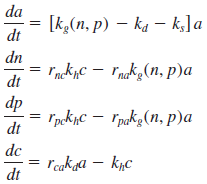The growth of floating, unicellular algae below a sewage treatment plant discharge can be modeled with the
Question:
The growth of floating, unicellular algae below a sewage treatment plant discharge can be modeled with the following simultaneous ODEs:

Where t = travel time (d), a = algal chlorophyll concentration (µgA/L), n = inorganic nitrogen concentration (µgN/L), p = inorganic phosphorus concentration (µgP/L), c = detritus concentration (µgC/L), kd = algal death rate (/d), ks = algal settling rate (/d), kh = detrital hydrolysis rate (/d), rnc = nitrogen-to-carbon ratio (µgN/µgC), rpc = phosphorus-to-carbon ratio (µgP/µgC), rna = nitrogen-to-chlorophyll ratio (µgN/µgA), rpa = phosphorus-tochlorophyll ratio (µgP/µgA), and kg(n, p) = algal growth rate (/d), which can be computed with

Where kg = the algal growth rate at excess nutrient levels (/d), ksp = the phosphorus half-saturation constant (µgP/L), and ksn = the nitrogen half-saturation constant (µgN/L). Use the ode45 and ode15s functions to solve these equations from t = 0 to 50 d given the initial conditions a = 1, n = 4000, p = 800, and c = 0.
Step by Step Answer:

Numerical Methods for Engineers
ISBN: 978-9352602131
7th edition
Authors: Steven C. Chapra, Raymond P. Canale





